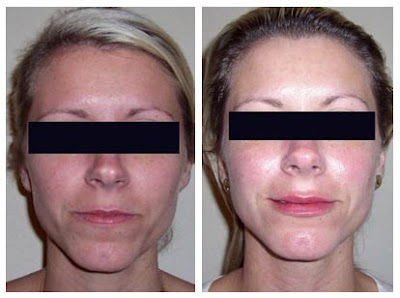Microdermabrasion surgery
Microdermabrasion is one of the more recent skin-care techniques or mechanical exfoliation that is one of the most popular, time-proven methods of consistent skin care that dramatically improve skin tone and texture in which the stratum corneum (dead outermost surface of the skin) is partially or completely removed by light abrasion, to remove sun-damaged skin and to remove or lessen scars and dark spots on the skin. It is Done with the help of micro aluminium oxide crystals or diamond tipped wand, leaving a new, fresh layer underneath.
It is the least invasive dermatological procedure (compared to dermabrasion and laser resurfacing).It is also more affordable than cosmetic/plastic surgery,chemical peels and Botox injections.
Microdermabrasion Pictures
Microdermabrasion is used to treat a variety of skin conditions including acne, stretch marks, acne scars, age spots, enlarged pores, wrinkles, or rosacea.It is Also effective on diminishing and even getting rid of fine lines, enlarged pores, blackheads, age spots, hyperpigmentation (uneven skin tone), scars, stretch marks, wrinkles and dull skin.
In addition, microdermabrasion stimulates the creation of collagen and cell turnover. Immediately following a microdermabrasion session the skin will feel smoother and have improved texture.
The typical session for microdermabrasion takes between 15 and 30 minutes. Most patients find it a quite pleasant experience.
The Microdermabrasion is a safe, common, non-surgical procedure however there are people who should not have it. People with active herpes lesions, active acne or rosacea, open sores or lesions, dermatitis, psoriasis, people using Accutane within the last 6 months, eczema, and lupus should not have microdermabrasion.
![[Microdermabrasion.jpg]](https://blogger.googleusercontent.com/img/b/R29vZ2xl/AVvXsEivzuWNaPQydI1Xp_QOOHkaGFn8MbfYGCfLtm9dATyWu9DU3gajiWqGXU5xAlHL8JPdZ60oJ6IMZJbhiguZZa8UIlLegWuRaf1HlzucYLGwSHEut9ClGVKLllBSX2YQU-GE-8C6WNMbvDkZ/s1600/Microdermabrasion.jpg)
Microdermabrasion, also referred to as mechanical exfoliation or micro-resurfacing, is a method for facial rejuvenation that uses a mechanical medium for exfoliation along with adjustable suction to remove away the outermost layer of dead skin cells from the epidermis. It is a non-invasive procedure, which is performed in-office by a trained skin care professional
Microdermabrasion has evolved from rocks, stones and shells to crystals, particle-free diamond tips and particle-free bristle tips. The popular, preferred method of mechanical exfoliation is particle-free over crystals. Once the desired amount of exfoliation has been reached, some microdermabrasion units will then infuse a skin specific solution into the skin. By infusing the solution, it will penetrate deeper than if applied manually for two reasons; the first is because the dead skin has been removed, so product penetration increases, the second is because the vacuum pressure works in reverse to push it in deeper. Results are significantly greater from microdermabrasion treatments combined with an infusion technique.
Mechanism
The skin’s surface is disrupted, cell division occurs which stimulates fibroblast activity leading to collagen production which leads to thicker, firmer skin.[1] Human skin sloughs off at a slower rate with age, so the exfoliation of several layers of the stratum corneum leaves skin fresh and radiant.
Benefits
Microdermabrasion may be performed to decrease the appearance of superficial hyperpigmentation, photo-damage, diminish fine lines, wrinkles, and shallow acne scars which helps to even out the texture. Removing the dead skin will aid in the penetration of skin care products by up to 50% and make-up will go on much more smoothly
History
The first microdermabrasion unit was developed in Italy in 1985, using small inert aluminium oxide crystals to abrade the skin. In 1986, other European markets had introduced the technology, which was immediately adopted by physicians for mechanical exfoliation. There were 10 microdermabrasion units on the market in Europe by the end 0f 1992. In 1996, Mattioli Engineering partnered with one of the Italian designed machines and started working towards meeting FDA requirements for the USA. By the end of 1996, the FDA issued the first approval letter for microdermabrasion machines. In January 1997, the first microderm machine was being sold and marketed in the US. The diamond tip was introduced in 1999 and the bristle tip was introduced in 2005.Microdermabrasion has evolved from rocks, stones and shells to crystals, particle-free diamond tips and particle-free bristle tips. The popular, preferred method of mechanical exfoliation is particle-free over crystals. Once the desired amount of exfoliation has been reached, some microdermabrasion units will then infuse a skin specific solution into the skin. By infusing the solution, it will penetrate deeper than if applied manually for two reasons; the first is because the dead skin has been removed, so product penetration increases, the second is because the vacuum pressure works in reverse to push it in deeper. Results are significantly greater from microdermabrasion treatments combined with an infusion technique.
Microdermabrasion Mediums
- Aluminium Oxide Crystals: 100 microns; aluminium oxide is relatively chemically inert and Generally recognized as safe. graded for purity; professional grade is 98.9% pure; irregularly shaped for effective exfoliation; controversy with potential health hazards using aluminium oxide crystals.
- Sodium Bicarbonate & Sodium Chloride Crystals: water-soluble and can be absorbed into the skin; gentle for sensitive skin.
- Organic Grains: used to buff and polish; made from trees, plants, agricultural crops, straw, reeds, maize, sunflower, cane sugar; non-toxic; great for sensitive skin; not as popular as other media used for microdermabrasion.
- Diamond Tips: can be natural but usually synthetic for lower costs; erythema (redness) is partially due to circulation rather than only irritation; no risk of inhalation or particles remaining embedded in the skin; varied coarseness of diamond wands or tips; diamond tips able to fit some crystal microdermabrators; diamond tips tend to dull from build-up of dead skin during treatment.








0 comments:
Post a Comment